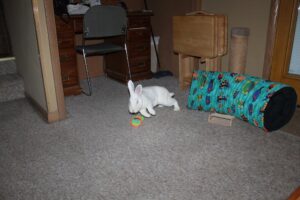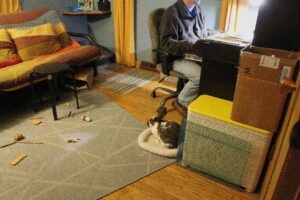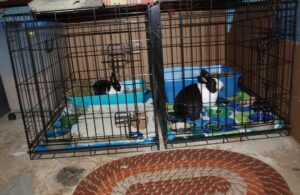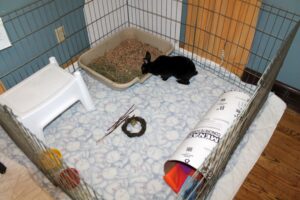Environment
Rabbits are most active in the morning and evening and sleep during the day and at night; hence, their schedule fits with those of active families. Rabbits should be given only as much freedom as they can handle; some rabbits can be free-range or cage-free outside all day, but some need greater limits.

Rabbits need 3-6 hours of exercise, stretch and playtime daily outside their cage. Rabbits are crepuscular, meaning they are going to be the most active in the evenings and mornings. Rabbits are curious and need regular social interaction. If using a cage or pen, set it up where you are active – like in a family room or kitchen. Rabbits enjoy listening to people and will often position themselves to watch you. If your rabbit is kept in a very active area (e.g. den or rec room), a small “cave” should be added so the rabbit has a safe place to lounge when stressed or tired; cardboard boxes with a hole cut in one end, paper bags, and milk crates turned on the side all work well.
Never let your rabbit go outdoors.

There are too many predators (two- and four-legged) that can directly or indirectly kill a rabbit, plus many insects carry diseases (myxomytosis, botfly, maggots, fleas, mites, etc.) that easily infect a rabbit that goes outdoors for any amount of time. Outdoor rabbits also suffer from undetected illnesses and loneliness.
Now with the threat of Rabbit Hemorrhagic Disease (RHDV2), it is even more important to keep your rabbits indoors at all times.
Temperature
Rabbits that are kept outdoors face extreme weather conditions. Sadly, we have seen many rabbits with missing ears caused by frost bite during the winter months. Rabbits belong indoors with your family.
Hot temperature is also a concern; rabbits are susceptible to heat stroke and will succumb to temperatures in the 80s F. Keep your rabbit in a cool room (60-70 F); on hot days run the air conditioner or place a plastic soda container filled with frozen water in the cage. A fan can be used to circulates the air. A ceramic tile can be placed on the floor to provide a cool surface for the rabbit to lay on.
If Using a Cage

We recommend using an 30 inch high exercise pen or extra large wire dog crate. We do not recommend cages with solid plastic bottoms, because their slick surface can lead to hip problems. Do not use wire bottomed cages, this can cause severe harm to your rabbit’s feet.
Cage Additions
Blankets, rugs and towels can be used to provide traction on slippery surfaces. For rabbits who like to chew their rugs, try woven grass mat squares(a common one used are sea grass mats). Place a large cat litter box inside the cage in a back corner for rabbits to use. Use a litter box of sufficient size; many rabbits like to lounge and sleep in their litter box. Place hay in the litter box to encourage good litter box habits. Change toys frequently to prevent boredom.
If Cage-Free
Many rabbits do not live in cages but have a room or area of the house that is their space. Baby gates and exercise-pen/pet fences work well to establish an area that will keep your rabbit safe and contained without being as limiting as life in a cage. Larger rabbits may be able to scale some pet fences and baby gates. You’ll need to observe your rabbit and see how high it is able to jump. Once the rabbit is used to using its litter box, you’ll want to be sure to rabbit-proof the room or space and be sure there are hiding places for your rabbit to rest and feel safe.

Rabbit-Proofing Your Home
Rabbit-proofing has three goals: (1) preventing destruction of your home; (2) protecting your rabbit from harm; and (3) providing safe chewing alternatives. Electrical cords look like branches and taste sweet; wrap these with spiral wrap plastic tubing or pre-slit tubing (any hardware supply stores). Tack loose wires to walls or molding, or bundle them into tubing or hard PVC pipes. Most houseplants should be considered toxic and should be kept from the rabbit’s reach; the House Rabbit Handbook (M. Harriman, Drollery Press) has a list of poisonous plants. Corners that are irresistible for chewing can be covered with furniture, throw rugs, woven grass mats or a hay tub. If your rabbit likes to burrow beneath furniture, block it off with a scrap lumber frame or staple hardware cloth across the underside (especially for sofas and mattresses). Protect wood molding with a wood tacking strip or a strip of double-sided scotch tape. Apply lemon oil soaked with hot chili peppers to furniture or wood; products such as Bitter Apple don’t work well for rabbits. Often rabbits chew furniture when they are bored or upset; provide lots of alternatives in the cage and outside (see toys below). It is often safest to keep your rabbit in a restricted area when you are asleep or not at home.
